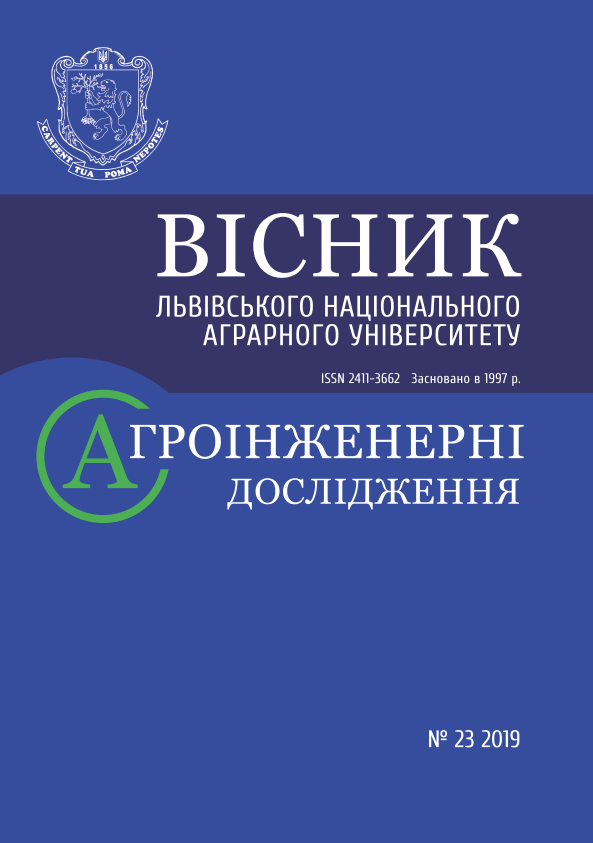COMPARISON OF THE ENERGY SAVINGS OF HOUSEHOLD ELECTRICITY SUPPLY SYSTEMS
DOI:
https://doi.org/10.31734/agroengineering2019.23.100Keywords:
power supply system, electricity losses, modeling of network modesAbstract
The electricity supplied by the energy supplying organizations to the consumers under the contracts acts as a commodity of a special kind, is characterized by the coincidence in time of the processes of production, transportation and consumption, as well as the impossibility of its storage and return. Accordingly, the concept of "quality" is applied to electricity, as for any type of product. Deviation of electricity quality indicators from the set standards exacerbates the operating conditions of electrical installations of both the network and consumers.
The analysis of scientific works, devoted to the problems of combating low-quality electricity in 0,38 / 0,22 kV power systems, shows that there are many methods and techniques available today to improve quality indicators and reduce electricity losses, but all because of its high cost, low reliability and efficiency are not widespread in the long utility lines. Therefore, the lack of a comprehensive approach to solution of the problem of electricity quality did not allow developing of objective recommendations on methods and technical means to reduce electricity losses.
Therefore, a comprehensive analysis of all factors that affect the energy savings and quality of electricity in power systems 0,38 / 0,22 kV will solve this problem and recommend cost-effective measures to reduce electricity losses. In this regard, it is necessary to design and build more energy efficient power systems, which would have several advantages over the existing power system, in which there is significant asymmetry of currents and voltages and significant losses of electricity.
References
Burbelo, M. Y., Melnichuk, C. M., & Nikitenko, M. V. (2011). Vymiriuvannia parametriv nesymetrichnykh shvydkozminnykh tryfaznykh navantazhen. Tehnichna elektrodinamika, 2, 54–56.
Denisiuk, S. P., & Horenko, D. S. (2016). Obminni protsesi v tryfaznykh avtonomnykh systemakh elektrozhyvlennia. Pratsi Institutu elektrodinamiki NAN Ukraiiny, 45, 9–15.
Miroshnyk, O. O., Dovhopola, A. S., Hlushach, E. V., & Romanenko, Ya. A. (2018). Doslidzhennia enerhooshchadnykh rezhymiv roboty rozpodilnykh merezh. Visnik HNTUSG im. P. Vasilenka «Problemy enerhozabezpechennia ta enerhozberezhennia v APK Ukraiini», 196, 24–26.
DSTU IEC 61000-4-30-2010. Elektromahnitna sumisnist (EMC). Ch. 4-30: Metodyky viprobuvannia ta vimiriuvannia. Vymiriuvanniya pokaznikiv yakosti elektrichnoii enerhii. [Chynnyi vid 2012-07-01]. Vyd. ofits. Kyiv. (2010).
Miroshnyk, O. O. (2011). Statystichne doslidzhennia osnovnykh parametriv silskykh merezh 0,38/0,22 kV. Naukovyi visnik Natsionalnohgo universitetu bioresursiv i prirodokoristuvannia Ukraiini. Seriia «Tekhnika ta enerhetika APK», 166(4), 203–211.
Bollen, M. H. J. (2002). Definitions of Voltage Unbalance. IEEE Power Engineering Review, 1, 49–50. doi: https://doi.org/10.1109/MPER.2002.1045567.
Chen, T.-N., & Cherng, J.-T. (2000). Optimal Phase Arrangement of Distribution Transformers Connected to a Primary Feeder for System Unbalance Improvement and Loss Reduction using a Genetic Algorithm. IEEE Transactions on Power Systems, 15, 994–1000. doi: https://doi.org/10.1109/59.871724.
Chitra, R., & Neelaveni, R. (2011). A Realistic Approach for Reduction of Energy Losses in Low Voltage Distribution Network. International Journal of Electrical Power & Energy Systems, 33, 377–384. doi: https://doi.org/10.1016/j.ijepes.2010.08.033.
Dilek, M., Broadwater, R. P., Thompson, J. C., & Sequin, R. (2001). Simultaneous Phase Balancing at Substations and Switches with Time-Varying Load Patterns. IEEE Transactions on Power Systems, 16, 922–928. doi: https://doi.org/10.1109/59.962447.
Faiz, J., & Ebrahimpour, H. (2006). Influence of Unbalanced Voltage Supple on Ef-ficiency of Three Phase Squirrel Cage Induction Motor and Economic Analysis. IEEE Transactions on Energy Conversion, 47, 289–302. doi: https://doi.org/10.1016/j.enconman.2005.04.009.
Faiz, J., & Ebrahimpour, H. (2007). Precise Derating of Three-Phase Induction Motors with Unbalanced Voltages. Energy Conversion and Management, 48, 2579–2586. doi: https://doi.org/10.1016/j.enconman.2007.03.023.
IEEE Standard, «Definition for the measurement of Electric Power Quantities under sinusoidal, nousinusoidal, balanced or unbalanced conditions» (IEEE std. 1459ТМ – 2010), IEEE Power and Energy Society, New York. (2010).
Jouanne, A., & Banerjee, B. (2001). Assessment of Voltage Unbalance. IEEE Transactions on Power Delivery, 16, 782–790. doi: https://doi.org/10.1109/61.956770.
Miroshnyk, O. O., & Tymchuk, S. O. (2013). Uniform distribution of loads in the electric system 0.38/0.22 kV using genetic algorithms. Technical Electrodynamics, 4, 67–73. Retrieved from: http://www.scopus.com/inward/record.url?eid=2-s2.0-84885913005&partnerID=MN8TOARS.
Verma, S., & Kumar, P. (2012). Smart Grid, Its Power Quality and Electromagnetic Compatibility. Islam, MIT International Journal of Electrical and Instrumentation Engineering, 1, 55–64.


